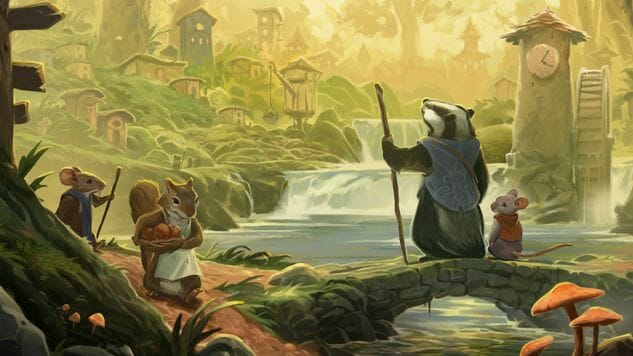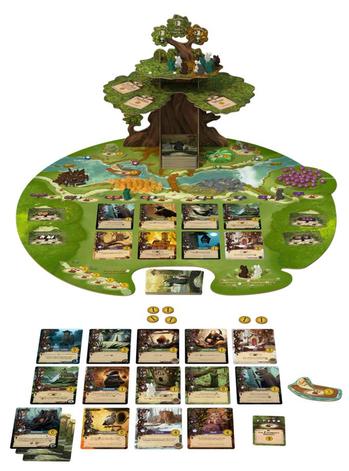The Beautiful Everdell Is One of the Best Board Games of the Year
Art courtesy of Starling Games Games Reviews board games
Everdell is the most gorgeous game I’ve played this year, and in this era of increasingly sophisticated board game art, that’s certainly saying something—and the underlying game is every bit as good as the artwork. The Starling Games booth had a demo out of the Everdell collector’s edition at Gen Con, and it was mobbed whenever I walked by, because the game itself is so visually appealing, not least because of the 3-D cardboard tree that sits at the head of the board. You really have to play it through a few times to appreciate how meticulous the design is, and how it lulls you into thinking it’s a simple worker-placement game when it’s actually a brilliant engine-builder that incorporates elements of Stone Age, Seasons, and even a hint of 7 Wonders, all in one game that you can play in under 90 minutes.
There are two kinds of board games that excite me as a reviewer or player at this point. A few games bring entirely new mechanics to the genre, and are worthy of praise for that even if the game play is a little rough around the edges. The other kind includes Everdell, a game that includes many mechanics or rules we’ve seen before, but brings them together in an entirely new way, and results in play that is fun and clever and gets everyone involved at the table. Designer James A. Wilson has hit on all cylinders with this, his first design, and manages to pack a lot of board game into a reasonable playing time.
Everdell pits players as forest creatures—the meeples are squirrels, turtles, hedgehogs, and mice—each trying to build a ‘city’ of cards on their personal tableaux. You send meeples out to gather resources (resin, stone, berries, and, yep, wood—if it’s a worker placement game, there will be wood) and can spend them to build cards from your hand or from the eight cards out on the ‘meadow’ at the center of the board. However, many cards come with a specific card name at the bottom of their images, and by playing that first card, you can build the second card for free, without paying any resources, a mechanic familiar to 7 Wonders players. You score points from the card values themselves, from being the first to collect certain combinations of card types, from triggering certain card events, and from bonuses on cards that reward you for specific card types in your city.
One of the most ingenious aspects of Everdell’s play is how it uses player meeples. You start the game in Winter, with just two meeples each, and gain one when you pull all your meeples back from the board and advance to Spring or Summer, then gain two when you advance to Autumn, the final season of the game. You need meeples to visit resource collection spaces, to claim event bonuses, and for a few other spaces on the board (there’s an Autumn track where you can go discard hand cards for points), but you don’t use meeples to build cards, neither from your hand nor from the board. If you have the resources, or have the card that allows you to build for free, you play the card to your city without burning a meeple to do so. Thus, meeples are a limited resource, but your decisions don’t require setting aside a certain number of meeples each round to ensure you have enough for building—you can set aside the ones you need for unique actions, like claiming events or perhaps playing on a card in your city, but that’s it.
Cards in Everdell get two different categorizations, both of which matter to game play. There are Critters and Constructions, and those can be Common or Unique. You can play multiple copies of the same Common card, but just one of each Unique card (which isn’t unique in the deck—every card has at least two copies in the giant deck from which all players draw). There are cards that give you a free resource or other bonus any time you play a new Critter or Construction, and there are cards that award bonuses for each Unique card you have at game-end. Cards also come in five types by function, which helps make it easier to remember what cards are triggered when. Some are triggered once when you play them, but never again; some are triggered when you place meeples on them; some are always active; and the most prevalent cards, with a green leaf on them, are triggered when they’re played, at the start of your Spring, and at the start of your Autumn, so playing those early in the game can be huge.
I have just two minor quibbles with Everdell, neither of which seriously affected our enjoyment of the game. One is that the deck is so large that you probably won’t get through more than half of it in a two or three player game and two-thirds in a four-player game, so it’s conceivable you’ll try to plan for a certain card to appear and never see it, either because all copies are near the bottom of the deck or because your opponents got the only copies that appeared. The diversity of cards in the deck is a strength of the game, however, so this is a tradeoff you probably will be willing to accept. The second is that by Summer and Autumn, you’re likely to have enough going on in your city—which can hold a maximum of 15 cards, although there are two exceptions to that I can remember—that you may forget to collect bonuses to which you’re entitled if you don’t pause on each turn to check. Those aforementioned cards that, say, give you a free berry every time you play a Critter card, are very valuable—but only if you remember to take what you deserve.
Everdell plays two to four players, and works just as well with two as with more; we’ve run two-player games inside of 45 minutes, and our longest game so far was our first one, about an hour and a half, including time to check the rule book for clarifications. The best score any of us has recorded so far is 62 points, in a two-player game, although winning scores have been closer to 50 in other games. There’s a lot of text involved and enough thinking ahead that I don’t think this is a great title for kids under 10 unless they’ve played a few games that incorporate similar mechanics, like 7 Wonders or even Race for the Galaxy—but most tableau builders are heavier games or just less elegant overall than Everdell is. And the artwork here by Andrew Bosley, who worked on recent reissues of Citadels and Mission: Red Planet, is off the charts. Rarely does a game look so good and then live up to that with its game play as Everdell does.
Keith Law is a senior baseball writer for ESPN.com and an analyst on ESPN’s Baseball Tonight. You can read his baseball content at search.espn.go.com/keith-law and his personal blog the dish, covering games, literature, and more, at meadowparty.com/blog.
